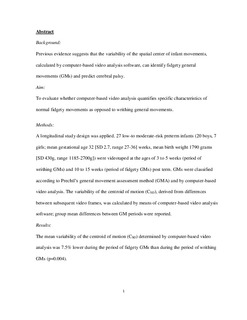Characteristics of general movements in preterm infants assessed by computer-based video analysis
Adde, Lars; yang, hong; Sæther, Rannei; Jensenius, Alexander Refsum; Ihlen, Espen Alexander F.; Cao, Jia-yan; Støen, Ragnhild
Journal article, Peer reviewed
Accepted version
Permanent lenke
http://hdl.handle.net/11250/2480721Utgivelsesdato
2017Metadata
Vis full innførselSamlinger
Originalversjon
10.1080/09593985.2017.1391908Sammendrag
Background: Previous evidence suggests that the variability of the spatial center of infant movements, calculated by computer-based video analysis software, can identify fidgety general movements (GMs) and predict cerebral palsy. Aim: To evaluate whether computer-based video analysis quantifies specific characteristics of normal fidgety movements as opposed to writhing general movements. Methods: A longitudinal study design was applied. Twenty-seven low-to moderate-risk preterm infants (20 boys, 7 girls; mean gestational age 32 [SD 2.7, range 27–36] weeks, mean birth weight 1790 grams [SD 430g, range 1185–2700g]) were videotaped at the ages of 3–5 weeks (period of writhing GMs) and 10–15 weeks (period of fidgety GMs) post term. GMs were classified according to Prechtl’s general movement assessment method (GMA) and by computer-based video analysis. The variability of the centroid of motion (CSD), derived from differences between subsequent video frames, was calculated by means of computer-based video analysis software; group mean differences between GM periods were reported. Results: The mean variability of the centroid of motion (CSD) determined by computer-based video analysis was 7.5% lower during the period of fidgety GMs than during the period of writhing GMs (p = 0.004). Conclusion: Our findings support that the variability of the centroid of motion reflects small and variable movements evenly distributed across the body, and hence shows that computer-based video analysis qualifies for assessment of direction and amplitude of FMs in young infants.
